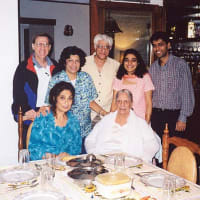さて、お約束通り今回からは、「The Open Organization」で有名なRed HatのブログにRonさんが寄稿しているエッセイなどを紹介いたします。
Red Hatは、企業向けオープンソース・ソリューションのプロバイダーとして世界をリードするソフトウエアの会社で、高性能な Linux、クラウド、コンテナ、および Kubernetes テクノロジーを提供しています。
本題に入る前に改めてRon McFarlandを紹介します。
Ron McFarland has been working in Japan for over 40 years, and he's spent more than 30 of them in international sales, sales management training, and expanding sales worldwide for Isuzu Motors. He's worked in or been to more than 80 countries. Over the past 14 years, Ron has established distributors in the United States and throughout Europe for a Tokyo-headquartered, Japanese hardware cutting tool manufacturer. More recently, he's begun giving seminars in Japanese to small Japanese companies wishing to expand both their exports and overseas investments. Also, he has been involved in supporting foreign companies interested in entering the Japanese market. You can find him on LinkedIn.
では、本題に入ります。初回のテーマは、「Globalization: A history of openness ~ The history of our interconnected world is also a history of our willingness to open up」。
1300ワードの記事ですが、3~4回程度に分けて掲載します。一気読みしたい方は、下記をクリック。では・・・・・
https://opensource.com/open-organization/20/7/globalization-history-open
In my career conducting international business, I traveled to more than 80 countries worldwide. I was always struck by how strongly regions of the world are connected, and I began studying the forces of globalization as a result.
Several books on this subject were critical to this research. But the one I'd like to highlight here is World 3.0: Global Prosperity and How to Achieve It by Pankaj Ghemawat. This book first taught me how little the global community is connected—but also how far it has come compared to the past. During Prof. Ghemawat's research, he worked with DHL and ultimately helped develop the DHL Global Connectedness Index, which tracks how well the global community is interacting in four key measurements: trade, investment, telecommunication, and travel/migration. From that work, I developed and delivered a presentation on global connectedness, which stressed that the world should increase its scores on those four measurements of globalization, as they are directly linked to food supply, health, security, pollution, jobs and other global benefits.
In this article series, I'll present my research from that period, then explain how we might think about the intersection of globalization and open organization principles around the world today. When people use terms like "globalization" and "global connectedness," in most cases what they really mean is "building coordinated communities to provide goods/service globally and address global issues." Open organization principles are applicable here—but in this context, on a global scale.
But before I can explain that interconnection, I'll first need to outline Prof. Ghemawat's criteria. In this article, I'll do that, with a special emphasis on the way open organization principles are critical to all of them.

齋藤信幸の生産財の営業はここ。
齋藤信幸のロングステイはここ。
Red Hatは、企業向けオープンソース・ソリューションのプロバイダーとして世界をリードするソフトウエアの会社で、高性能な Linux、クラウド、コンテナ、および Kubernetes テクノロジーを提供しています。
本題に入る前に改めてRon McFarlandを紹介します。
Ron McFarland has been working in Japan for over 40 years, and he's spent more than 30 of them in international sales, sales management training, and expanding sales worldwide for Isuzu Motors. He's worked in or been to more than 80 countries. Over the past 14 years, Ron has established distributors in the United States and throughout Europe for a Tokyo-headquartered, Japanese hardware cutting tool manufacturer. More recently, he's begun giving seminars in Japanese to small Japanese companies wishing to expand both their exports and overseas investments. Also, he has been involved in supporting foreign companies interested in entering the Japanese market. You can find him on LinkedIn.
では、本題に入ります。初回のテーマは、「Globalization: A history of openness ~ The history of our interconnected world is also a history of our willingness to open up」。
1300ワードの記事ですが、3~4回程度に分けて掲載します。一気読みしたい方は、下記をクリック。では・・・・・
https://opensource.com/open-organization/20/7/globalization-history-open
In my career conducting international business, I traveled to more than 80 countries worldwide. I was always struck by how strongly regions of the world are connected, and I began studying the forces of globalization as a result.
Several books on this subject were critical to this research. But the one I'd like to highlight here is World 3.0: Global Prosperity and How to Achieve It by Pankaj Ghemawat. This book first taught me how little the global community is connected—but also how far it has come compared to the past. During Prof. Ghemawat's research, he worked with DHL and ultimately helped develop the DHL Global Connectedness Index, which tracks how well the global community is interacting in four key measurements: trade, investment, telecommunication, and travel/migration. From that work, I developed and delivered a presentation on global connectedness, which stressed that the world should increase its scores on those four measurements of globalization, as they are directly linked to food supply, health, security, pollution, jobs and other global benefits.
In this article series, I'll present my research from that period, then explain how we might think about the intersection of globalization and open organization principles around the world today. When people use terms like "globalization" and "global connectedness," in most cases what they really mean is "building coordinated communities to provide goods/service globally and address global issues." Open organization principles are applicable here—but in this context, on a global scale.
But before I can explain that interconnection, I'll first need to outline Prof. Ghemawat's criteria. In this article, I'll do that, with a special emphasis on the way open organization principles are critical to all of them.

齋藤信幸の生産財の営業はここ。
齋藤信幸のロングステイはここ。



























